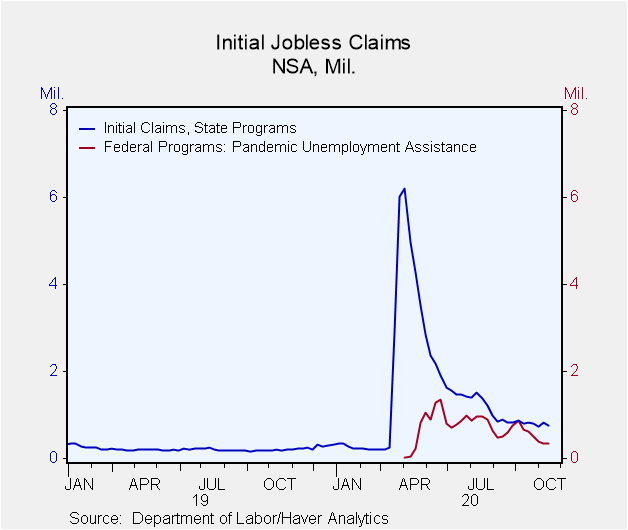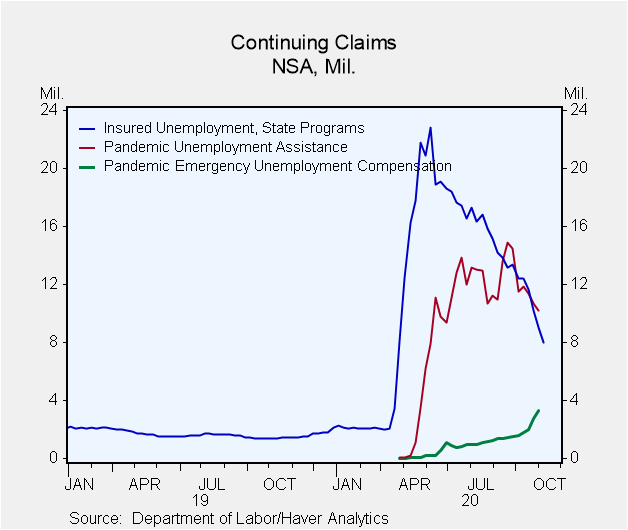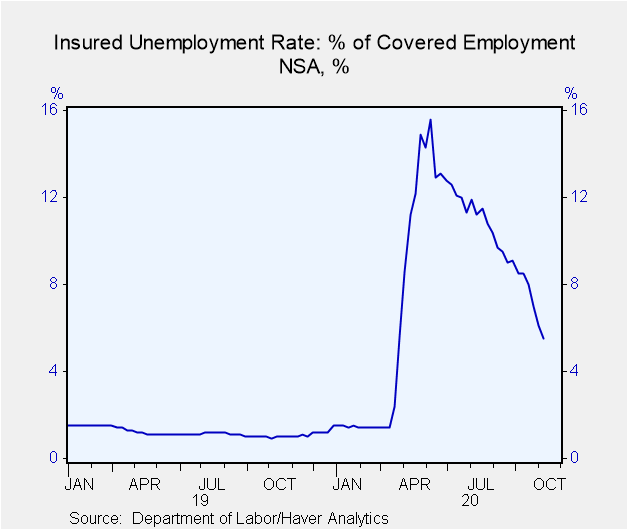 Global| Oct 22 2020
Global| Oct 22 2020U.S. Jobless Claims Fall in October 17 Week; California Numbers Now Updated
Summary
• State initial claims fall 55,000 seasonally adjusted in October 17 week, almost reversing prior week's increase. • Federal Pandemic Unemployment Assistance initial claims rise 8,212, first increase in 6 weeks. • Regular state and [...]
• State initial claims fall 55,000 seasonally adjusted in October 17 week, almost reversing prior week's increase.
• Federal Pandemic Unemployment Assistance initial claims rise 8,212, first increase in 6 weeks.
• Regular state and PUA continuing claims declined again while PEUC continued upward march.
• California completed its processing updates, with actual national totals showing sizable downward revisions.
Seasonally adjusted state initial claims for unemployment insurance fell 55,000 in the week ending October 17 to 787,000 from 842,000 in the previous week. Importantly, these amounts include downward revisions as California completed its processing update. The Action Economics Forecast Survey estimated 860,000, obviously based on the pre-revision levels. Additionally, a change in the calculation of seasonal adjustment factors from multiplicative to additive created a break in the series in late August. Though the current week-to-week comparison is valid, the comparison to August 22 is not. For more details, please see the September 3 commentary on jobless claims.
The impact of the California revisions was sizable: the national totals for initial claims in the October 3 week were reduced by 78,000 and in the October 10 week, 56,000.
The not seasonally adjusted data, which are comparable across all periods for initial claims, fell 73,000 to 757,000 in the week ending October 17. The October 10 week's amount was revised down from 886,000 to 830,000.
Haver Analytics has calculated a methodologically consistent seasonally adjusted data series. As these data illustrate, our calculated seasonal adjustment factors very closely match the Department of Labor seasonals.
Claims for the federal Pandemic Unemployment Assistance (PUA) program, which covers individuals such as the self-employed who are not covered by regular state unemployment insurance, rose 8,212 to 345,440, interrupting a five-week downtrend.
Seasonally adjusted state continuing claims for unemployment insurance -- which are also impacted by the California revisions -- fell to 8.373 million in the week ending October 10, from 9.397 million in the October 3 week. Haver Analytics methodologically consistent seasonally adjusted continuing claims showed the same readings for October 10, and a miniscule 1,000 difference the week before those weeks and finds the October 3 number is the lowest level of continuing claims since March 28. The California revisions resulted in a 627,000 reduction in the total number of people receiving regular unemployment insurance in the October 3 week.
Not seasonally adjusted continuing claims dropped to 7.992 million from 9.011 million, also the lowest since late March.
Continuing PUA claims, which are lagged an additional week and not seasonally adjusted, declined to 10.232 million from 10.659 million. Meanwhile, Pandemic Emergency Unemployment Compensation claims showed a sizable increase to 3.296 million in the October 3 week from 2.786 million the week before. This program covers people who were unemployed before COVID but had exhausted their state benefits and are now eligible to receive an additional 13 weeks of unemployment insurance, up to a total of 39 weeks.
The seasonally adjusted state insured rate of unemployment fell to 5.7% in the week ending October 10 from 6.4% the week before. The not seasonally adjusted rate dropped to 5.5% from 6.1%, the lowest since the March 21 week. These data do not include the federal pandemic assistance programs. If you include the latest data available, which is lagged one additional week, the total number of state, PUA and PEUC continuing claims declined to 24.197 million or 15.1% of the labor force. This is the lowest since April.
The insured rates of unemployment for individual states -- which do not include the special federal programs -- continued to show wide variation. The lowest rates in the October 3rd week were in Idaho (1.13%), South Dakota (1.30%), Alabama (1.40%), Utah (1.43%) and Nebraska (1.70%). The highest rates were in Louisiana (8.76%), Georgia (9.27%), Nevada (11.27%), California (11.51%) and Hawaii (14.90%. The rate in New York was 7.66%, in Illinois 7.55%, and Texas 5.78%. These state rates are not seasonally adjusted.
Data on weekly unemployment claims going back to 1967 are contained in Haver's WEEKLY database, and they are summarized monthly in USECON. Data for individual states are in REGIONW. The expectations figure is from the Action Economics Forecast Survey, carried in the AS1REPNA database.
| Unemployment Insurance (SA, 000s) | 10/17/20 | 10/10/20 | 10/03/20 | Y/Y % | 2019 | 2018 | 2017 |
|---|---|---|---|---|---|---|---|
| Initial Claims | 787 | 842 | 767 | 269 | 218 | 221 | 244 |
| Initial Claims (NSA) | 757 | 830 | 731 | 305 | 218 | 221 | 243 |
| Initial Claims Pandemic Unemployment Assistance (NSA) | 345 | 337 | 379 | -- | -- | -- | -- |
| Continuing Claims | -- | 8,373 | 9,397 | 395 | 1,701 | 1,756 | 1,961 |
| Continuing Claims (NSA) | -- | 7,992 | 9,011 | 476 | 1,704 | 1,763 | 1,964 |
| Continuing Claims Pandemic Unemployment Assistance (NSA) | -- | -- | 10,233 | -- | -- | -- | -- |
| Insured Unemployment Rate (%) | -- | 5.7 | 6.4 |
1.2 |
1.2 | 1.2 | 1.4 |
Carol Stone, CBE
AuthorMore in Author Profile »Carol Stone, CBE came to Haver Analytics in 2003 following more than 35 years as a financial market economist at major Wall Street financial institutions, most especially Merrill Lynch and Nomura Securities. She has broad experience in analysis and forecasting of flow-of-funds accounts, the federal budget and Federal Reserve operations. At Nomura Securites, among other duties, she developed various indicator forecasting tools and edited a daily global publication produced in London and New York for readers in Tokyo. At Haver Analytics, Carol is a member of the Research Department, aiding database managers with research and documentation efforts, as well as posting commentary on select economic reports. In addition, she conducts Ways-of-the-World, a blog on economic issues for an Episcopal-Church-affiliated website, The Geranium Farm. During her career, Carol served as an officer of the Money Marketeers and the Downtown Economists Club. She has a PhD from NYU's Stern School of Business. She lives in Brooklyn, New York, and has a weekend home on Long Island.









